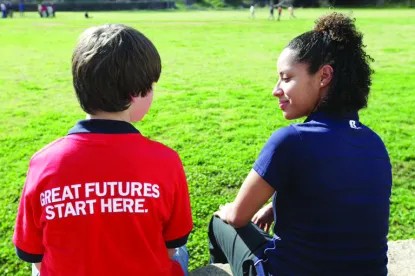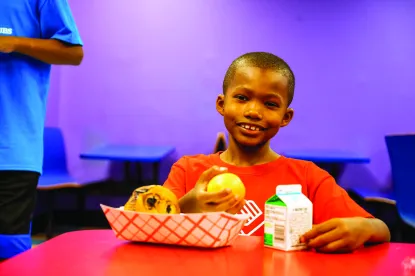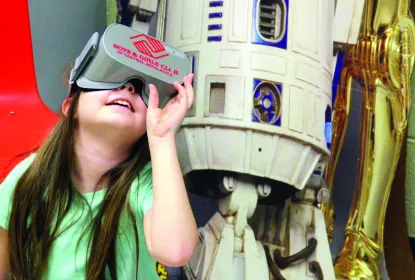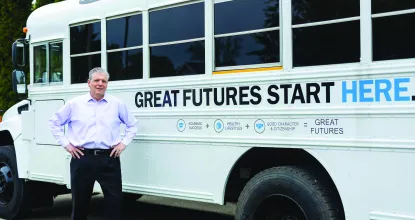
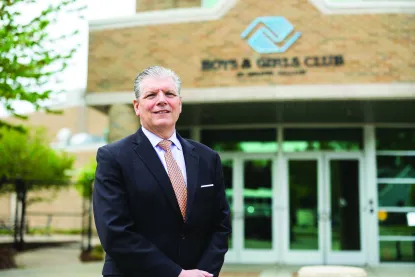
"We believe every kid has what it takes."
That’s the philosophy of Boys & Girls Clubs of America, which provides safe, positive and inclusive environments for youth and teens – of every race, ethnicity, gender, gender expression, sexual orientation, ability, socioeconomic status and religion – so they can reach their full potential.
That’s also the driving motivation of Brian Manderfield ’88 BS, who has committed his career to the organization, joining it after graduating from NMU and serving the past 20 years at the national level, the past five as national vice president, government relations.
“Helping kids is really important,” he said. “I would not have the same drive working in another industry, trying to drive policy change and building out our infrastructure.”
"It's very rewarding - to know and see how the Club can change a young person's life. 54% say the club literally saved their lives."
Today, Boys & Girls Clubs of America (BGCA) has nearly 4,900 club sites throughout the U.S. Like many organizations, they are in recovery mode as the pandemic wanes, but when they are once again at full capacity, they will provide a safe, educational and fun place for more than 4.6 million kids and teens annually. Even when the country was shut down, the vast majority of clubs stayed open to serve children of essential workers, provide meals to kids and families and even became testing and vaccine sites.
Manderfield got a taste of the impact of BGCA in his first post overseeing three inner-city clubs in Phoenix, Arizona. One story he related was of young Mona Dixon, who was living on the street with her mom, with no shelter but a box. “Club staff brought her in and got them off the street, assisted in finding them physical shelter and the promise of being a Club member,” he recalled. “Mona grew up to be our National Youth of the Year. She got her master’s at Arizona State University and her doctorate from Grand Canyon University. She is just one example of many. For some, it is just a safe place to go; for others it totally changes their trajectory.”
“It’s very rewarding – to know and see how the Club can change or save a young person’s life,” he added. “From a survey of alumni, 54% say the club literally saved their lives.”
Manderfield also discovered powers in himself he did not know he had. “I saw real value and ability in myself to drive success in partnerships and meeting the greatest needs of our young people. I developed a strong interest engaged in pulling together city, churches, nonprofits, law enforcement, businesses, and other caring community members to support and create these spaces.”
He also eventually developed a reputation in south Phoenix in those years: “They said if you need something, go find Brian, the big white guy. I’d try to help with what was needed, or provide needed advice to a teen like, ‘The NBA is not going to recruit you as a drop out — get back to school!”
When an opportunity arose to build a Boys & Girls Club organization nearly from scratch in his home state of Michigan, Brian and his wife, Marianne, (whom he met in Marquette), moved to Holland, where as executive director, he helped transition the Club from only operating out of schools, by further building a board with community-minded folks, raising resources, and buying and renovating a building for the Club’s new home.
There he met Club member Chris Gale, who was being raised by a single mother who worked incredibly hard but was also dealing with her own physical mobility issues in a wheelchair. “The Club was everything to him,” Manderfield said. “He became our Local, State and Regional Youth of the Year, eventually graduated from college and got his master’s and is now the chief program officer of a community agency in Philadelphia. He has three kids and is married, and I feel fortunate that we have been able to stay in touch over the years.”
During that time, Manderfield did a lot of work with city, county and government officials as well, with the national BGCA Government Relations team. On the federal side, they were seeing shifts, where access to federal partnerships were coming through at the state and local levels. “The idea of building out 501c4 state alliances – creating a mechanism for each state’s affiliated B&G Club to be able to partner with state government and leverage our scope and scale — was really exciting,” he said. “The downside was leaving the work that was so impactful at the local level. But I saw the ability for me to have more impact by putting my time, experience and efforts into our movement, and growing Alliances to scale.”
Those state alliances grew into 47 (though BGCA is in all 50 states) and allow each to identify the greatest needs for school-aged children within their state. The resources secured stay within a state and go directly to the Clubs. Manderfield explained that in his role, “We don’t go and ask for money, we ask for how we can partner to address a need within a state. In Georgia, for instance, we have partnered with a state agency that invests $8 million and we match that 3:1 with private funds. This $32 million initiative is able to provide programs and services in 115 different Club sites throughout the state. We have shown that our clubs and programs lead to decreased interaction with law enforcement, alcohol and other drug use and increased academic success. The state is getting that for less than what they could do by themselves or with any other partners
He explained that while the Clubs only see an average of 20% of funding from government sources and don’t depend on any one particular type of government grant, they often work hand-in-hand.
This past year BGCA celebrated the 30th anniversary of its partnership with the U.S. military. All military installations in the U.S. and abroad that have children and families on them – over 400 — also have BGCA programs in their Military Youth & Family facilities.
“Our military kids move around so much,” Manderfield said. “The one thing that was stable in their lives, they say, was that there would be a club wherever they ended up. And it would be there supporting them when their mom or dad was deployed and away from home.”
BGCA is also the largest provider of services on Native American and Native Alaskan lands, with over 200 club sites, helping to bridge the gap of tremendous need and lack of resources in many of these communities.
Across the country, with everything children have been through, Manderfield said the Clubs are needed now more than ever, with effects of the pandemic coming to surface.
“It’s not just learning loss, this is about addressing unfinished learning,” he said. “First through third graders, as an example, are further behind in their development and education as they move from learning to read to reading to learn. Even though our teachers and schools did an incredible job in the most challenging circumstances, our kids and country will be dealing with this for a long time. Our clubs are really focused on that right now.
“Physical and emotional safety is also a priority. There is a great need for security and belonging; to transition from isolation, where many may have a home setting that may not have been functional – from abuse to food insecurity – and from the trauma brought about by lack of face-to-face interaction and an unknown future. They are also experiencing the trauma of losing or being removed from family and friends. Our volunteers and staff
— from caring adults to professional service providers — need to be specially trained to provide additional support. Sometimes it’s just someone to talk to; sometimes it’s more.” As with many organizations at this time, staffing it also a challenge. “We need to find the right people,” Manderfield explained. “These staff and volunteers are truly special in the work that they do.”
Manderfield, who admitted to not being the strongest student himself during his first two years at NMU, also experienced life-changing loss when he took a year-and-a-half off to be with his mom, who had cancer. Despite that, he said it was one of the best times of his life, to be able to spend it with her. “When I went back to school, after mom died, it was a whole different commitment. I was a changed person. Northern was a great place to be, and then to come back to. I could not imagine any other place to go to after that. It was like going back home.” At that point, he fully embraced business and marketing and the continuous improvement model, which he applies to the 160-year-old Boys and Girls Clubs of America.
“It’s been 34 years and I feel blessed and very fortunate to be able to do the things I do and with the great people I work with, and what we’ve done. In the 20 years with BGCA, our State Alliance work has driven more than $1.9 billion in funding to Clubs and has provided positive policy and regulatory changes to further support and protect kids and teens.”
So many have been impacted by Boys and Girls Clubs over the years. Some alumni are very well known, such as Magic Johnson, Denzel Washington and Jennifer Lopez. But BGCA alumni are also incredible scientists, educators, military and business leaders. Manderfield has had the opportunity to meet many of them, and those who champion the Clubs.
“As I reflect on the path this journey has taken me — from having lunch with Sandra Day O’Connor, introducing Club kids to General Colin Powell, who was on our board of governors, and even being in the Oval Office with our Youth of the Year to meet with President Clinton, who is an alumnus — I am always amazed and wonder, what is this Wildcat doing here and what is the common thread that brings us together?
“I make the connection that we all believe every kid has what it takes for a great future – I guess every Wildcat as well!”
By Rebecca Tavernini '11 MA
